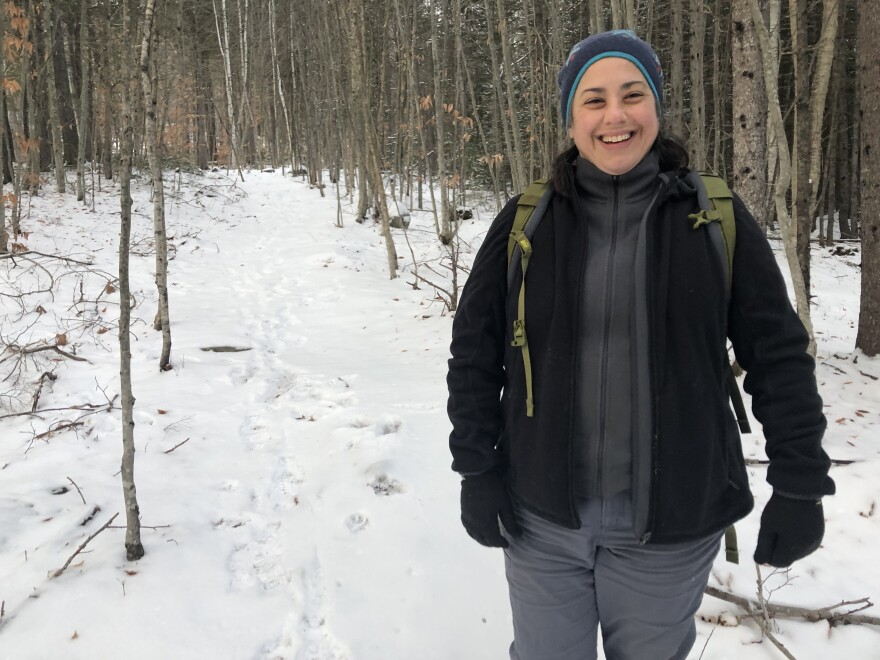Winter is losing ground in Maine, and as warming continues it will pose new challenges for the state's winter recreation economy.
Ski areas are increasingly focused on two sides of the sustainability question — how to keep snow on the slopes and how to reduce pollution from their energy-intensive operations.
This story is part of our series "Climate Driven: A deep dive into Maine's response, one county at a time."
Founded in 1960, Mt. Abram Family Resort in Greenwood was one of Maine's first ski areas to adopt snow-making technology. Earlier this month, some of the equipment was showing its age, with a pipe break that has forced mountain operations chief Brian Dunham and a handful of companions into triage mode.
It has been a pretty dry December so far, and the push is on to get a solid cover of snow on the mountain's 250 acres of terrain with skiing potential in time for the revenue-rich holiday period. The drive was hampered by too few days when temperatures dropped below the 28 degrees needed to turn water into snow. And that marks a significant shift.
"We used to start making snow here the first of November," Dunham says.
Dunham has had a hand in mountain operations since the 1980s. He says that in recent years, even December temperatures aren't what they used to be, with daytime temperatures often too warm, and nighttime freezes harder to come by, too.
"And we're not getting that normal December two-week cold snap that we used to have," he says. "In fact, in the last ten years — I'm a maple producer, and everything has set back almost two weeks. So everything is … yeah, it's getting warmer if you believe it or not."

The data bear him out. The Northeast is warming faster than other parts of the nation, with median winter temperatures in Maine rising some 5 degrees since the early 1900s.
"For Maine, we've lost about three weeks of winter in the past hundred years," says Sarah Nelson, a former University of Maine atmospheric scientist and now the Appalachian Mountain Club's research director.
In 2019, Nelson and other scientists published a comprehensive analysis of winter in the Northeast, using datasets that go back a century.
"It was really clear from the results of our research that winter has changed, it's continuing to change, and new work that's coming out is showing that it will continue to change," she says.
The team looked at metrics such as the number of days temperatures stay below zero, or below freezing, or when will it be cold enough to kill off invasive mosquitoes. And key to the ski areas' interests, they found that there are now 21 fewer days with natural snow cover, and 18 fewer days cold enough for snowmaking before the Christmas holiday week.

There are some limits to the data, Nelson notes, and at higher altitudes Maine's western mountains are likely retaining winter's attributes a little better than the state as a whole — but the trend's direction is the same, she says, and significant. AMC, she adds, is opening new, more detailed research into whether the upper alpine zones can serve as a kind of "refugia" for winter.
Walking up a snow-dusted trail in Bethel, Nelson adds that the trends accelerated in the last few decades. And she says that new research is focusing on rising instances of winter whiplash — what skiers think of as dreaded "freeze-thaw" days.
"In the middle of January maybe we have a bunch of snow on the ground, and — this has happened in several of the past years — we'll get a rainstorm. It was 80 degrees in March 2012. What is that doing to the ecology as well as the economic sectors?" she says.

More such days can be expected, Nelson says.
Just a few miles away, the Sunday River ski resort is cranking up its 2,000 snow guns. General Manager Brian Heon is piling up snow for the holidays. The guns build up huge humps of snow — "whales," as they are called — that can offer some protection against warmth and rain.
"So if we saw potentially a rain event coming after that, we wouldn't spread it out. We'd leave it in piles, let it sit, let the rain do its thing, then when the cold temperatures come, then we spread the snow back out," he says. "So it's not only the making of the snow, but it's also it's the management of the snow after you make it."
Some recent analyses contend that under moderate to severe warming, northern New England ski areas will have to amp up snowmaking capacity by at least 80% to keep the slopes covered all season past 2050.
That's a climate conundrum, because it takes a lot of electricity or diesel fuel to pipe water and compressed air uphill — adding greenhouse gases to the atmosphere. Ski areas acknowledge as much, although they keep details fairly close to the vest. And the technology, Heon says, has taken a big leap forward in recent years.

"This is making phenomenal snow, using a lot less energy than older technology," he says.
The corporation that operates Sunday River, Sugarloaf and Shawnee Peak has committed to carbon-neutral operations by 2030. Over the last two years, with help from Efficiency Maine, Sunday River has spent more than $1 million on new guns and retrofits.
The ratepayer-financed Efficiency Maine has seeded almost $10 million worth of upgrades at various Maine resorts. Agency director Michael Stoddard says the latest systems use 60-90% less energy than a decade ago.
"These mountains have seen the writing on the wall that it's getting warmer, gradually, and they need to be making these investments. And I think the good news is this should put them in a really good position to be viable for decades to come," he says.
Expanded snowmaking will, of course, mean using more water as well. Western Maine right now is in an unusually prolonged period of moderate to severe drought, possibly related to climate change. Maine's biggest mountains use hundreds of millions of gallons of water for snowmaking each year. But their operators say they are committed to investing in water storage and reuse systems to avoid damaging drawdowns in local streams and rivers.
For smaller mountains like Mt. Abram, added snowmaking, energy conservation and water management will be a heavy lift, says General Manager Greg Luetje.
"We don't have those deep pockets. And we constantly talk about water and water supplies, and how do we use less diesel, can we use airless compressors, and everything is a challenge," he says.
Luetje says he is confident the mountain will be up to the task, and it has already installed new snow-gun nozzles that don't use compressed air. And some new help could be on the way — the recent federal infrastructure law includes money for improved energy systems that advocates believe can be tapped by the ski industry.



